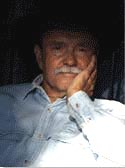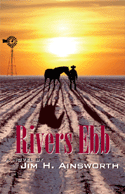Today, I have the pleasure to introduce to you Jim Ainsworth, nor only a talented writer, but one of the nicest persons you are likely to meet. And such an interesting person that we’d better get started so we don’t run out of time and space. I understand you got into writing in an unusual way. Tell is how that happened.
a talented writer, but one of the nicest persons you are likely to meet. And such an interesting person that we’d better get started so we don’t run out of time and space. I understand you got into writing in an unusual way. Tell is how that happened.
JIM: I had a traditional CPA firm in a small town for about fifteen years. I offered the traditional services of tax preparation and advice, accounting, audit, etc. When my clients asked me to go further in helping them achieve their financial goals, I got the licenses and added financial planning to my practice. Five years later, intending to take the lessons we had learned nationwide, I wrote a training manual for our representatives. That manual found its way to a small town in Montana and a fellow there told me to send it to an editor he knew at John Wiley and Sons in New York. Six weeks later, I had a publishing contract that eventually led to four books. I thought this writing and publishing thing was easy. How wrong I was.
JRC: How interesting. I believe your first narrative non-fiction book was Biscuits Across the Brazos. An unusual name. Where did that come from?
 JIM: My father’s family migrated from West Texas to Northeast Texas in 1918 in a covered wagon. Daddy was seven at the time. His beloved Aunt Minnie made him homemade biscuits the morning they left. She gave him two extra to carry with him. On the trail the next morning, he realized he might never see Aunt Minnie again and saved the biscuits. I still have those biscuits. I took them on the trip we made in 1998 to commemorate their journey made eighty years earlier. We tried to do everything they would have done during that trip and generally succeeded in stepping back eighty years in time.
JIM: My father’s family migrated from West Texas to Northeast Texas in 1918 in a covered wagon. Daddy was seven at the time. His beloved Aunt Minnie made him homemade biscuits the morning they left. She gave him two extra to carry with him. On the trail the next morning, he realized he might never see Aunt Minnie again and saved the biscuits. I still have those biscuits. I took them on the trip we made in 1998 to commemorate their journey made eighty years earlier. We tried to do everything they would have done during that trip and generally succeeded in stepping back eighty years in time.
JRC: You actually made such a trip – in a covered wagon – nowadays? That’s pretty amazing. Tell us a little about that?
JIM: We made the trip from Ranger in Eastland County to Cooper in Delta County. 325 miles in two weeks. Two white mules pulled an old Studebaker covered wagon. My friend Charles Horchem drove the mules. My cousin, Marion Ainsworth and I rode horseback the entire way (his father is my dad’s brother who also made that earlier trip). A lot of family members rode along for a day or two. We had more than a few adventures and met a lot of great people who let us spend the night in their pastures or in their barns.
JRC: We could do an entire interview on that trip. But, I promised to talk about writing today. So, tell us a little about your latest book.
JIM: Go Down Looking has been at Tate Publishing for just over nine months and will be out in April or early May. This is the fourth in a series of books where Jake Rivers is the protagonist. The first book begins when Jake is nine and living in Northeast Texas. The third ends when he is sixteen and living alone in the Panhandle. This book begins just as Jake leaves to follow his parents back to Northeast Texas. Are you beginning to see a pattern in my family migrations? They have been migrating back and forth across Texas for almost 150 years. This book takes Jake though the remainder of his troubled high school and college years and the first jolting years of his career. I hope readers will enjoy the “Then and Now” segments at the beginning and end of this book where Jake speaks in first person as an old man.
JRC: Wow. I really like the sound of the “Then and Now” segments. Fill us in a little on what went between “Biscuits” and Go Down Looking.
JIM: There are three books in the follow the Rivers trilogy. Rivers Flow, Rivers  Crossing, and Rivers Ebb. My fourth novel is Home Light Burning. This book takes us back to the end of the Civil War and deep into Reconstruction Texas. It tells of the first migration across Texas for the Ainsworth family. This migration was forced, however, because my ancestors were fugitives. The title comes from what I always thought was a family legend. The story was that my great-grandfather was a fugitive for several years, but always camped close enough to his house to protect his family. My great-grandmother kept a lantern on the porch that he saw each night. I researched it off and on for about forty years. When I finally proved that the story was true and why it happened, I had to write about it. I made it a novel because I had to fill in some blanks that I could not confirm. But the main thrust of the story is definitely true. Rivers Flow, by the way, will soon be out in as an e-book. I hope the others will be out soon after.
Crossing, and Rivers Ebb. My fourth novel is Home Light Burning. This book takes us back to the end of the Civil War and deep into Reconstruction Texas. It tells of the first migration across Texas for the Ainsworth family. This migration was forced, however, because my ancestors were fugitives. The title comes from what I always thought was a family legend. The story was that my great-grandfather was a fugitive for several years, but always camped close enough to his house to protect his family. My great-grandmother kept a lantern on the porch that he saw each night. I researched it off and on for about forty years. When I finally proved that the story was true and why it happened, I had to write about it. I made it a novel because I had to fill in some blanks that I could not confirm. But the main thrust of the story is definitely true. Rivers Flow, by the way, will soon be out in as an e-book. I hope the others will be out soon after.
JRC: Well, you’ve certainly piqued my interest in Home Light Burning. It sounds like you have turned out a bunch of books in a short time. What is your writing schedule like?
 JIM: If you leave out those four business books, I have averaged a book every two years. My writing schedule varies. I don’t write every day. I see writing as something to be enjoyed, not endured, so I am pretty easy with myself when I miss a day or two because of other pressing matters or because I am just not inspired. I average three to four days a week and write about three to four hours a day. I like to write at least a thousand words a day. I am blessed with a quiet, private place to write.
JIM: If you leave out those four business books, I have averaged a book every two years. My writing schedule varies. I don’t write every day. I see writing as something to be enjoyed, not endured, so I am pretty easy with myself when I miss a day or two because of other pressing matters or because I am just not inspired. I average three to four days a week and write about three to four hours a day. I like to write at least a thousand words a day. I am blessed with a quiet, private place to write.
JRC: What do you have planned for the future? Continue the “Rivers” series, or branch out into something else?
JIM: I have a sixth novel in manuscript form. My goal is to write a completely different book with a new protagonist. However, I am getting a little resistance to leaving Jake behind. I like to write about things I know and people I have encountered and fictionalized. I find it difficult to just write complete fiction from nothing but my imagination. I always wonder if I can make it believable. If I know it happened (or something very similar), then I can relax and fit the pieces together, content in the knowledge that something like this could happen and in fact, did happen.
JRC: For those of us who can’t write financial Planning books, do you have any suggestions on how to get into today’s publishing world?
JIM: I had a fortuitous beginning when a friend referred me to an editor at a big house. I had no idea how lucky that was. I have come to the conclusion that most agents and publishers are found just this way (referral by another writer or friend). However, nobody came forward to help with my novels or the non-fiction book. I have self-published and been published by micro and mini presses. My current book is with a bigger house and I am enthusiastic. It is certainly a lot easier to self-publish today than when I started. Advice? Attend the seminars and workshops. Get a professional editor to edit your work if you self-publish. Read all the books and magazines you can on writing and publishing. Read books like you want to write—lots of them. Finally, write regularly and often.
JRC: Thanks, Jim, for a great interview. We ought to schedule an interview sometime just on the wagon trip you made across Texas in 1998. I’m sure there are many great stories there. If any of you readers would like to hear more about Jim’s wagon trip across Texas, drop us a comment.

JR thank you for the interview with Jim, I love the titles of his books. Biscuits Across the Brazos sounds like great reading (I flew from the East Coast ti the West Coast with 2 biscuits in my carry on), as well as the other books. Thank you for sharing. Augie
I admire writers who are proud of their heritage and incorporate it into their writing.I can understand why Jim is getting “a little resistance” about leaving his Rivers series behind; it sounds fascinating. I’d be willing to bet the resistance isn’t just coming from his publisher. I imagine it’s coming from his readers and himself.